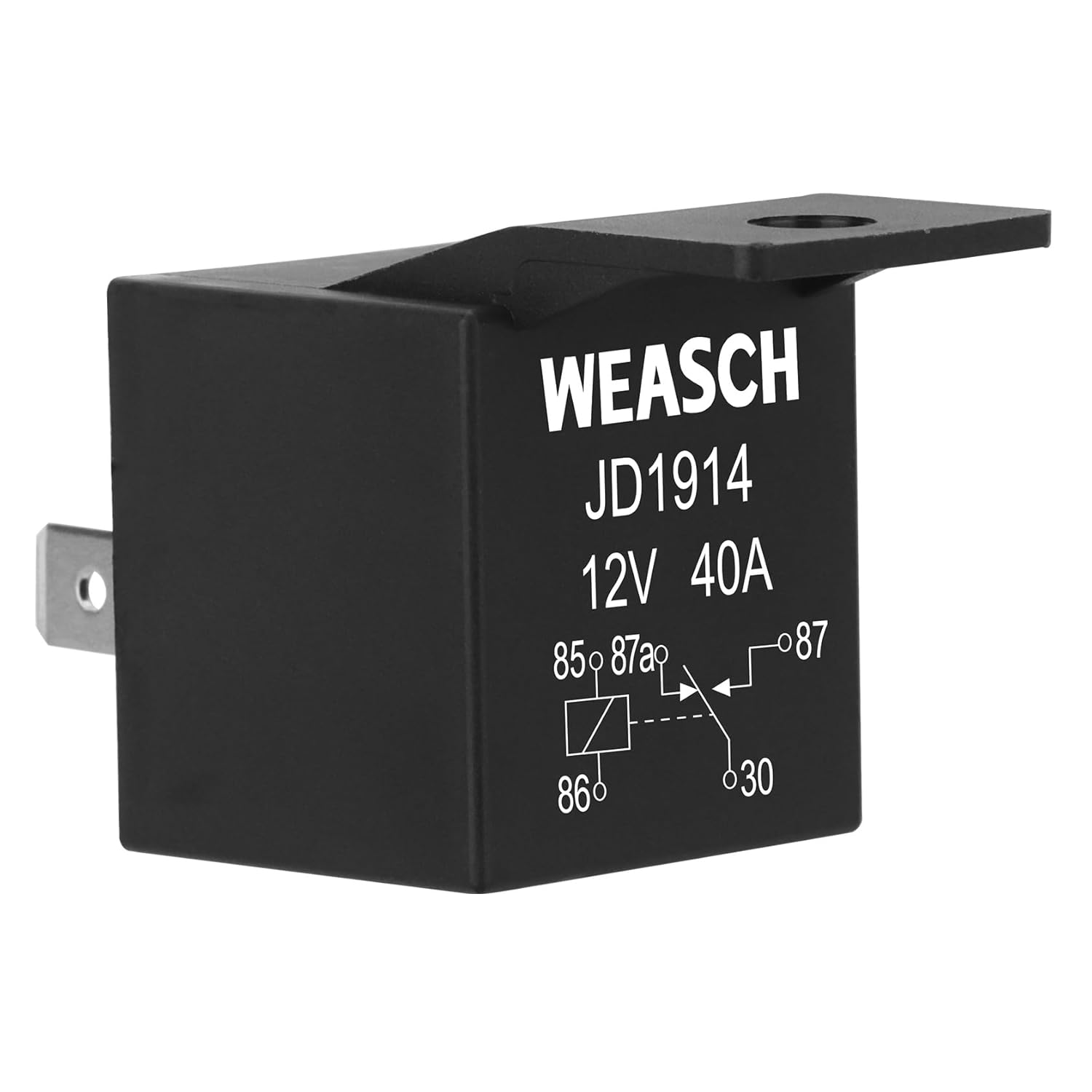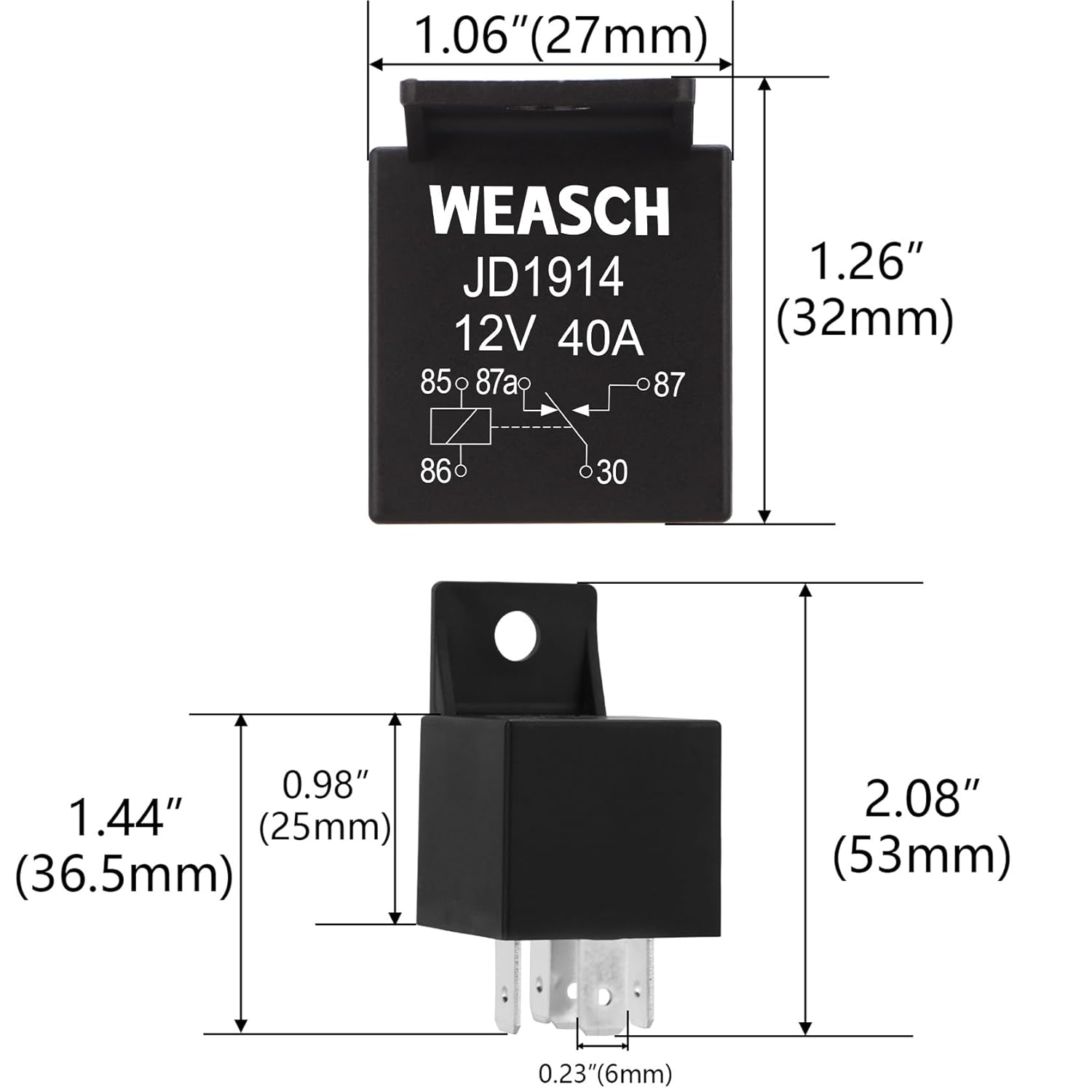- Product Name: Car Relay; Model: JD1914
- Rated Voltage: 12VDC; Max.Operating Current: 40A
- Contact: SPDT; Number of Pins: 5
- Contact Material: Ag Alloy; Insulation Resistance: ≤ 100MΩ
- Package Content: 2 x JD1914 Car Relay
 True Mods 12V DC 120 Amp Split Charge Relay Switch - 4 Terminal Relays for Truck Boat Marine
*$301.00
True Mods 12V DC 120 Amp Split Charge Relay Switch - 4 Terminal Relays for Truck Boat Marine
*$301.00
 Electric Fuel Pump Relay Kit Fuel Pump Wiring Harness Bypass 40 AMP Waterproof Switch Heavy Duty Long Wires Universal Fit 12V System P/N 30247
*$553.00
Electric Fuel Pump Relay Kit Fuel Pump Wiring Harness Bypass 40 AMP Waterproof Switch Heavy Duty Long Wires Universal Fit 12V System P/N 30247
*$553.00
Frete Grátis em todo o BrasilProduto Original Importado dos EUA
2 Pack JD1914 Car Relay, 12V 40A, 5 Pin SPDT, Automotive Switches and Starters, Waterproof Relay for Boat Tractor Truck Motorcycle (2)
*$213.70
Informação adicional
| Connector Type | Plug-In |
|---|---|
| Contact Material | Silver Alloy |
| Contact Type | Normally Closed, Normally Open |
| Current Rating | 40 Amps |
| Mounting Type | Plug In Mount |
 Frete Grátis em todos os produtos
Frete Grátis em todos os produtos
















wardog8844 –
旧車のリレー増設に使用しました。ヘッドライトリレーとして使っていますがLEDだと10Aも流れないので、40Aを開閉できるかは分かりません。
長期的な耐久性は不明なものの、300回程度の開閉で問題なく動作していることは確認しています。
Amazingなお客様 –
自動車部品の代替として問題なく使えます。
価格も手頃で5極はありがたいです!
Darryn –
My son recently added an auxiliary horn to his car that was wired up with a 5 pin relay. I didn’t have a waterproof one available and when he went to the auto parts store to get one they gave him one that is not waterproof. Because of this, I ordered these to have on hand in the event that his stops working. We now have these to replace that one if needed.
Amazon Customer –
This automotive relay is comparable to the vast options of the same thing. The relay has a common (term 30) where when no power is supplied has continuity on terminal 87a, When 12 volts dc are applied to the coil (term 85 and 86) then continuity is on terminal 87. The continuity shifts from one to the other when relay is on or off and they cannot both be active at the same time. The time for the relay to shift is in the m-seconds. This relay has a 40 amp max capacity.
Uses for this relay varies, it possibly could be used as a starter, for emergency use. You would only need to use the common to battery positive lead and term 87 would go to the starter motor. This is wasteful / prone for problems as the unused term 87a would be energized any time the coil is off. If nothing was connected to that terminal and a good weather proof cap was installed then perhaps would work for a long time that way. A proper starter switch would be using a ST (single throw) relay. That type relay only has the 87 terminal, thus removing potential shorts from the equation.
Now that you may understand the basic usage for a relay, then a better use for this type of relay would be for a latching circuit. A latch in a circuit is when power is present from a trigger then gets ‘latched’ or otherwise kept on once the trigger is removed. So, if you were to start a motor with a press of a button, once the button was released then the motor would continue to be started until the latch is released. A latch usually consists of two relays where one is the latch and the other is the release.
The layout of a latch is fairly simple. Provide a constant power supply on relay one common. Relay one NO term is tied to its own relays coil…with the releasing relays NC circuit in between this circuit. When power is applied to relay one coil it stays energized once the trigger is removed as the NO circuit is active. The only way to turn off relay one is by energizing the release relay. That causes the release relay NC circuit to open and power on the latch circuit is removed. Research ‘latch’ for relays online for pictorial images if you are a visual type person to understand. A latch is highly useful in electronics. You don’t need to hire someone to hold the button, you build a circuit to do it instead!
A highly advanced type of latch would be called a polarized latching relay. The coil is controlled via a pulse rather than constant voltage. These are neat and used in high voltage transfer switches. Solar power systems being such an application. Also with these you do not need constant power to hold the relay in the NC state. These are very efficient because of that. It will blow your mind on how they function though. Take a peek at Gruner Relay 740.